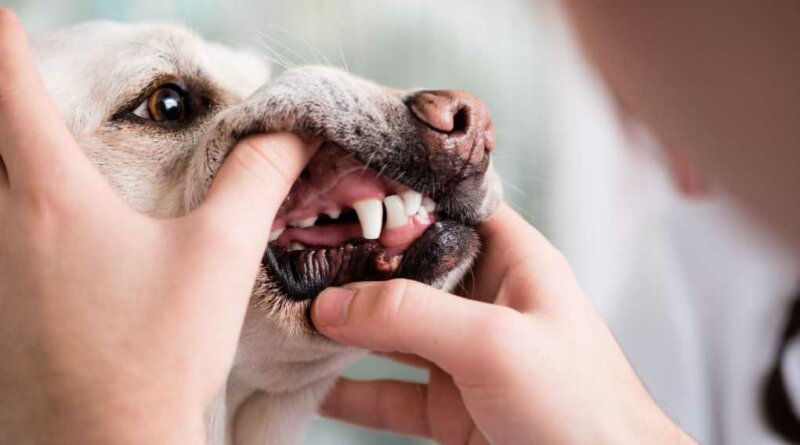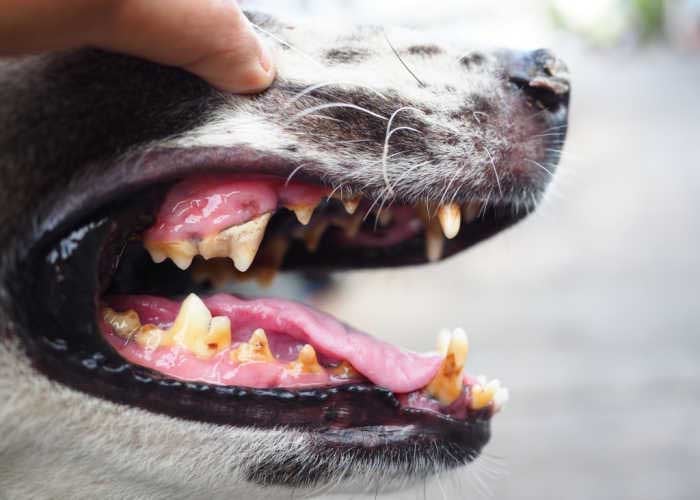Signs, Causes & Treatments – Top Dog Tips
You may have thought bad breath is simply something your pooch just happens to have, but it could be an indication of gum infection in dogs.
Sure, the smell may not be minty fresh, but it also shouldn’t be so horrible to make you sick.
So, does this mean that dogs need oral care?
Absolutely!
Their oral health is equally as important as ours to prevent dental problems and tooth decay.
However, not all dog owners maintain their dog’s oral health as often as they do their own.
They overlook the significance of dental hygiene when it comes to maintaining their pets’ well-being.
That’s why we will focus on dog gum infection and how it affects our furry pals.
Gum Infection in Dogs
Periodontal disease in dogs, commonly referred to as dog gum disease, causes progressive damage to the supporting structures of the teeth as a result of oral bacteria.
Dogs rarely exhibit visible signs of the infection until the condition has progressed to an advanced stage since it lurks below the gums.
As a result, it’s crucial to start your dog’s preventative dental care at a young age.
According to the American Veterinary Dental College, the majority of dogs begin to develop symptoms of this illness by the age of three.
Poor dental care, genetics, and the structure of their mouths can make dogs more susceptible to periodontal disease.
The condition is more common in small and toy dog breeds as well as those with short snouts.
You may wonder what causes this gum problem in dogs. Well, you should know that when the teeth aren’t brushed, a fuzzy, white substance called plaque forms on them.
Plaque is full of dangerous bacteria that will build up on your dog’s teeth if they are not brushed every day.
It will mineralize and turn into dental calculus, often known as tartar.
Plaque sticks to tartar more easily than it does to the tooth’s smooth, natural surface, so tartar allows for more plaque to accumulate.
Eventually, that plaque will penetrate deeper into the structures around the tooth, causing inflammation of the gums.
The soft tissues and bone that support the teeth will then be destroyed as a result of the body’s natural inflammatory reaction to the plaque.
Signs and Symptoms
Halitosis, or bad breath, is one of the obvious indicators of periodontal disease in dogs.
This may be misunderstood by some owners as typical “doggy breath,” but it’s not. It implies that there is a problem inside your pet’s mouth.
Other symptoms to watch for include:
- difficulty in chewing, particularly when it comes to hard food or treats
- broken or missing teeth
- excessive drooling
- bleeding or inflamed gums
- difficulty at opening or closing the mouth
- a growth or lump inside the mouth
As the infection advances, you might also notice certain behavioral changes. Your dog could:
- no longer tolerate brushing his teeth due to sore gums
- change his eating patterns or prefer to chew on one side of the mouth
- flinch or flee when you attempt to lift his lips to look at his teeth
- become more distant or hostile
- be hesitant to play with chew toys
If any of these signs appear, call your veterinarian at once.
Early detection can help you avoid further harm, health issues, and perhaps even tooth loss.
Additionally, you’ll be easing the discomfort that gum disease produces.
Diagnosis and Stages
Every visit to the clinic should include a brief dental examination.
But if your dog has an oral infection, then a thorough oral examination needs to be done.
Your vet might perform a visual examination in addition to dental x-rays and bone loss measurement tools.
Gum infection in dogs can be broken down into four stages:
Stage 1
The gums become slightly swollen (gingivitis). Tartar buildup may also be visible in some areas. The tooth’s support is still intact at this point.
Stage 2
When there is a mild to moderate loss of the bone and ligaments that support teeth in place, early periodontitis is detected.
The gums are redder and/or more inflamed at this point.
Stage 3
When up to 50% of the tooth’s support has been lost, moderate periodontitis is confirmed.
Stages 2 and 3 teeth don’t appear noticeably different to the naked eye, but an x-ray will reveal more bone loss at Stage 3.
Stage 4
Advanced periodontitis indicates 50% or more bone loss.
In this final stage, tartar is visible to the naked eye, the gums are receding, the teeth are damaged, and tooth extraction may be necessary.
Have your pup checked at least once or twice a year because early intervention against this gum problem in dogs may be able to save your pet’s teeth.
Even if your dog is behaving normally, follow your veterinarian’s advice if they suggest dental care.
Is Gum Infection in Dogs Reversible?
The only reversible stage is gingivitis, Stage 1. There may be inflammation at this point but it does not affect the supporting structure of the teeth.
Although not reversible, stages 2 and 3 of periodontal disease in dogs may not advance to stage 4 with proper treatment.
Dog Gum Infection Treatment
The extent of this gum problem in dogs will determine the course of treatment.
Stage 1: To treat gingivitis in dogs and stop plaque buildup, a professional dental cleaning and fluoride application are recommended.
Stages 2 and 3: To remove plaque and tartar buildup, the teeth will require a deep cleaning or scraping, both above and below the gum line.
The vet will next polish the teeth to create a smooth surface that makes it harder for bacteria and plaque to stick to the tooth.
General anesthesia is always required for this surgery.
Stage 4: When the condition reaches this stage, surgery, which usually entails extractions, will probably be required to treat the afflicted teeth that can no longer be saved due to infection, bone loss, or pain.
Prevention of Periodontal Disease in Dogs
Gum infection in dogs can be prevented, or at least minimized, by doing the following:
- brushing your dog’s teeth regularly
- examining the mouth for bad breath or any abnormalities, such as redness, tartar, or loose teeth
- feeding your pet high-quality food and treats to help control tartar
- oral examination every six months if your dog is prone to the disease
FAQs about Gum Infection in Dogs
Is gum disease in dogs curable?
With daily brushing and adequate oral care, gingivitis in dogs is treatable and curable.
It’s when a dog reaches the second stage of periodontal disease that the damage is irreversible.
However, it can be stopped from getting worse with constant at-home care and routine dental cleanings.
Is gum disease in dogs fatal?
If left untreated, not only is it painful but periodontal disease can have serious health effects on a dog’s entire body.
Eye problems, a higher risk of organ damage, jaw fractures, oral cancer, oronasal fistulas, and tooth abscesses are a few of these health problems.
Can I reverse gum disease in dogs?
Thorough dental cleaning and polishing help reverse gingivitis in dogs (gum inflammation), but once it advances, the damage cannot be undone.
Gum Infection in Dogs: Final Thoughts
A pet can be a wonderful addition to any family.
But caring for them is a responsibility that should not be taken lightly.
They depend on us to look after them since they don’t get to tell us what they feel.
That goes not only for their general health but also for their dental health.
After all, the last thing you want is for your pooch to get sick because of gum infection in dogs.
So, as owners, we act in a way that we believe is best for their welfare.
Even though dental diseases are common in dogs, our furry friends don’t have to suffer from them.
Diligent at-home dental care with routine dental examinations will help our dogs keep their bright smile until their golden years.
Yes, it requires dedication, but one that is necessary for your fluffballs to remain healthy.
READ NEXT: Dog Gum Problems: What to Look Out For
Related








